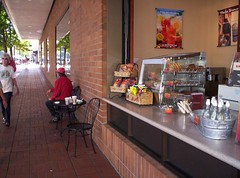Why it's okay to give tax increment financing to department stores but you still need to think long and hard about where you put your money

I used to be against this, but then I heard a presentation by Bob Gibbs, one of the nation's leading retail consultants, at the Congress for the New Urbanism meeting in DC in 2003(?), and he made a good case given that department stores (and supermarkets) spend a lot of money on advertising, which drives people to their stores, and as importantly, to the stores around them. That's why they are called anchors... and that's why the big box model requires more questioning before providing money, because for the most part, big box stores, particularly WalMart, have business models that don't support the development of shopping "districts" and/or independent retail around their locations.
Adding a Nordstroms to Georgetown is worth considering for incentives. See "D.C. in Talks to Bring Nordstrom to Georgetown," subtitled "Mall Deal Could Open Other Shops," from the Post.
HOWEVER, for the city as a whole and in terms of the opportunity costs of taxpayer supported incentives, having a Nordstroms downtown is a lot more important than having a Nordstroms in Georgetown. That is the kind of anchor that downtown needs to strengthen its critical mass of retail.
If Nordstroms can have a store in Portland on Pioneer Courthouse Square, they can have a store in downtown DC.

Espresso Window, Nordstrom Dept. Store, Pioneer Courthouse Square, Portland, Oregon.
I believe that the redevelopment plans for the Old Convention Center site had "hoped" to attract Nordstroms. I guess that is out of the question now?
Or not? Again, in Portland, there is a Nordstroms located downtown, and at the shopping mall (an urban renewal inititiative) just outside downtown, Lloyd Center.
I do understand Georgetown's concerns too. They have to make sure that their commercial district remains competitive vis-a-vis other competitive shopping districts within the region, which includes Friendship Heights, traditional malls and megamall centers (like Tysons), while maintaining their distinctive urban feel and walkability.
OTOH, Georgetown has been "reproduced" in the classical definition of "gentrification" (a word I don't like generally, but is apt here). See:
-- Is there a link between historic designation and chaining up of retail in neighborhood commercial districts?
-- and this article from the New York Times about Georgetown's chief retail gentrifier, Anthony Lanier, "Developer Infuses Historic Properties With Commerce."
However, people shouldn't expect such retail to be spread around the city. Retailers go to the best places, those that already work, those that have the kind of demographics, transportation access, and customer base that they are comfortable with.
Most retailers aren't in the business of pioneering in (re)emerging commercial districts.
In other words, don't tell me that Brookland needs a Starbucks or x or y. I already know. (And you don't want to sit and listen to me explain how retailers think. Even for Starbucks, read the book Pour Your Heart Out.)
Making the case for such retail--and note that I prefer independents, but understand how well known businesses (chains) setting high standards for service and value are also desirable, especially in generating feelings of comfort on the part of people less willing to shop in places that are unfamiliar to them.
See these old blog entries for more about this topic:
-- Why the future of urban retail isn't chains (reprinted from July 2005)
-- Store siting decisions (reprinted from July 2005)
Labels: commercial district revitalization, economic development, retail, tax incentives



0 Comments:
Post a Comment
<< Home